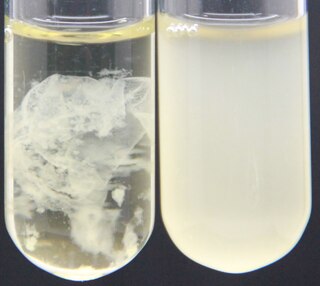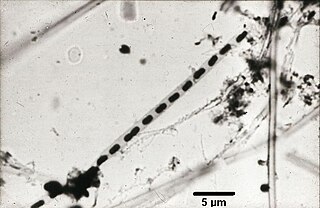
Pseudomonadota is a major phylum of Gram-negative bacteria. The renaming of phyla in 2021 remains controversial among microbiologists, many of whom continue to use the earlier names of long standing in the literature. The phylum Proteobacteria includes a wide variety of pathogenic genera, such as Escherichia, Salmonella, Vibrio, Yersinia, Legionella, and many others. Others are free-living (nonparasitic) and include many of the bacteria responsible for nitrogen fixation.

The Nitrosomonadales are an order of the class Betaproteobacteria in the phylum "Pseudomonadota". Like all members of their class, they are Gram-negative.

The Rhodocyclales are an order of the class Betaproteobacteria in the phylum "Pseudomonadota". Following a major reclassification of the class in 2017, the previously monofamilial order was split into three families:

The Comamonadaceae are a family of the Betaproteobacteria. Like all Pseudomonadota, they are Gram-negative. They are aerobic and most of the species are motile via flagella. The cells are curved rod-shaped.
The Hydrogenophilaceae are a family of the Hydrogenophilalia, with two genera – Hydrogenophilus and Tepidiphilus. Like all "Pseudomonadota", they are Gram-negative. All known species are thermophilic, growing around 50 °C and using molecular hydrogen or organic molecules as their source of electrons to support growth - some species are autotrophs.
Acidithiobacillus is a genus of the Acidithiobacillia in the "Pseudomonadota". The genus includes acidophilic organisms capable of iron and/or sulfur oxidation. Like all "Pseudomonadota", Acidithiobacillus spp. are Gram-negative. They are also important generators of acid mine drainage, which is a major environmental problem around the world in mining.

Betaproteobacteria are a class of Gram-negative bacteria, and one of the eight classes of the phylum Pseudomonadota.
Thauera is a genus of Gram-negative bacteria in the family Zoogloeaceae of the order Rhodocyclales of the Betaproteobacteria. The genus is named for the German microbiologist Rudolf Thauer. Most species of this genus are motile by flagella and are mostly rod-shaped. The species occur in wet soil and polluted freshwater.

Spirillaceae is a family in the order Nitrosomonadales in the class Betaproteobacteria of the bacteria.
Dechloromonas is a genus in the phylum Pseudomonadota (Bacteria).
Azoarcus is a genus of nitrogen-fixing bacteria. Species in this genus are usually found in contaminated water, as they are involved in the degradation of some contaminants, commonly inhabiting soil. These bacteria have also been found growing in the endophytic compartment of some rice species and other grasses. The genus is within the family Zoogloeaceae in the Rhodocyclales of the Betaproteobacteria.
Azonexus is a genus of gram-negative, non-spore-forming, highly motile bacteria that is the type genus of the family Azonexaceae which is in the order Rhodocyclales of the class Betaproteobacteria.
Azovibrio is a genus of bacteria from the order Rhodocyclales which belongs to the class of Betaproteobacteria, but the family to which it belongs is uncertain since it falls in between the Zoogloeaceae and the Rhodocyclaceae. Up to now there is only on species known.
Ferribacterium is a genus of bacteria from the family of Rhodocyclaceae which belongs to the class of Betaproteobacteria. Up to now there is only one species of this genus known.

Zoogloea, also known as zoöglœa, is a genus of gram-negative, aerobic, rod-shaped bacteria from the family of Zoogloeaceae in the Rhodocyclales of the class Betaproteobacteria.
Acidithiobacillus thiooxidans, formerly known as Thiobacillus thiooxidans until its reclassification into the newly designated genus Acidithiobacillus of the Acidithiobacillia subclass of Pseudomonadota, is a Gram-negative, rod-shaped bacterium that uses sulfur as its primary energy source. It is mesophilic, with a temperature optimum of 28 °C. This bacterium is commonly found in soil, sewer pipes, and cave biofilms called snottites. A. thiooxidans is used in the mining technique known as bioleaching, where metals are extracted from their ores through the action of microbes.
Bacteriovorax is a genus containing a single species of bacterium in the family Bacteriovoracaceae, Bacteriovorax stolpii. It is a predator that feeds on larger Gram-negative bacteria. These prey bacteria tend to live in enteric environments and have similar lipopolysaccharide structures. Bacteriovorax stolpii recognizes its prey by outer membrane protein receptors, which explains why Gram-positive bacteria that lack outer membranes do not serve as prey. They prey on bacteria by invading the interperiplasmic space where they feed, grow, and reproduce. Bacteriovorax stolpii used to be classified in the genus Bdellovibrio because of similar morphologies and lifestyle characteristics, however they were recognized as a new genus through phylogenetic analysis.
The genus Annwoodia was named in 2017 to circumscribe an organism previously described as a member of the genus Thiobacillus, Thiobacillus aquaesulis - the type and only species is Annwoodia aquaesulis, which was isolated from the geothermal waters of the Roman Baths in the city of Bath in the United Kingdom by Ann P. Wood and Donovan P. Kelly of the University of Warwick - the genus was subsequently named to honour Wood's contribution to microbiology. The genus falls within the family Thiobacillaceae along with Thiobacillus and Sulfuritortus, both of which comprise autotrophic organisms dependent on thiosulfate, other sulfur oxyanions and sulfide as electron donors for chemolithoheterotrophic growth. Whilst Annwoodia spp. and Sulfuritortus spp. are thermophilic, Thiobacillus spp. are mesophilic.
The class Hydrogenophilalia in the Bacteria was circumscribed in 2017 when it was demonstrated that the order Hydrogenophilales was distinct from the Betaproteobacteria on the basis of physiology, biochemistry, fatty acid profiles, and phylogenetic analyses on the basis of the 16S rRNA gene and 53 ribosomal protein sequences concatenated using the rMLST platform for multilocus sequence typing.
Ann Patricia Wood is a retired British biochemist and bacteriologist who specialized in the ecology, taxonomy and physiology of sulfur-oxidizing chemolithoautotrophic bacteria and how methylotrophic bacteria play a role in the degradation of odour causing compounds in the human mouth, vagina and skin. The bacterial genus Annwoodia was named to honor her contributions to microbial research in 2017.




